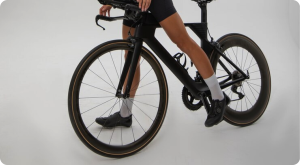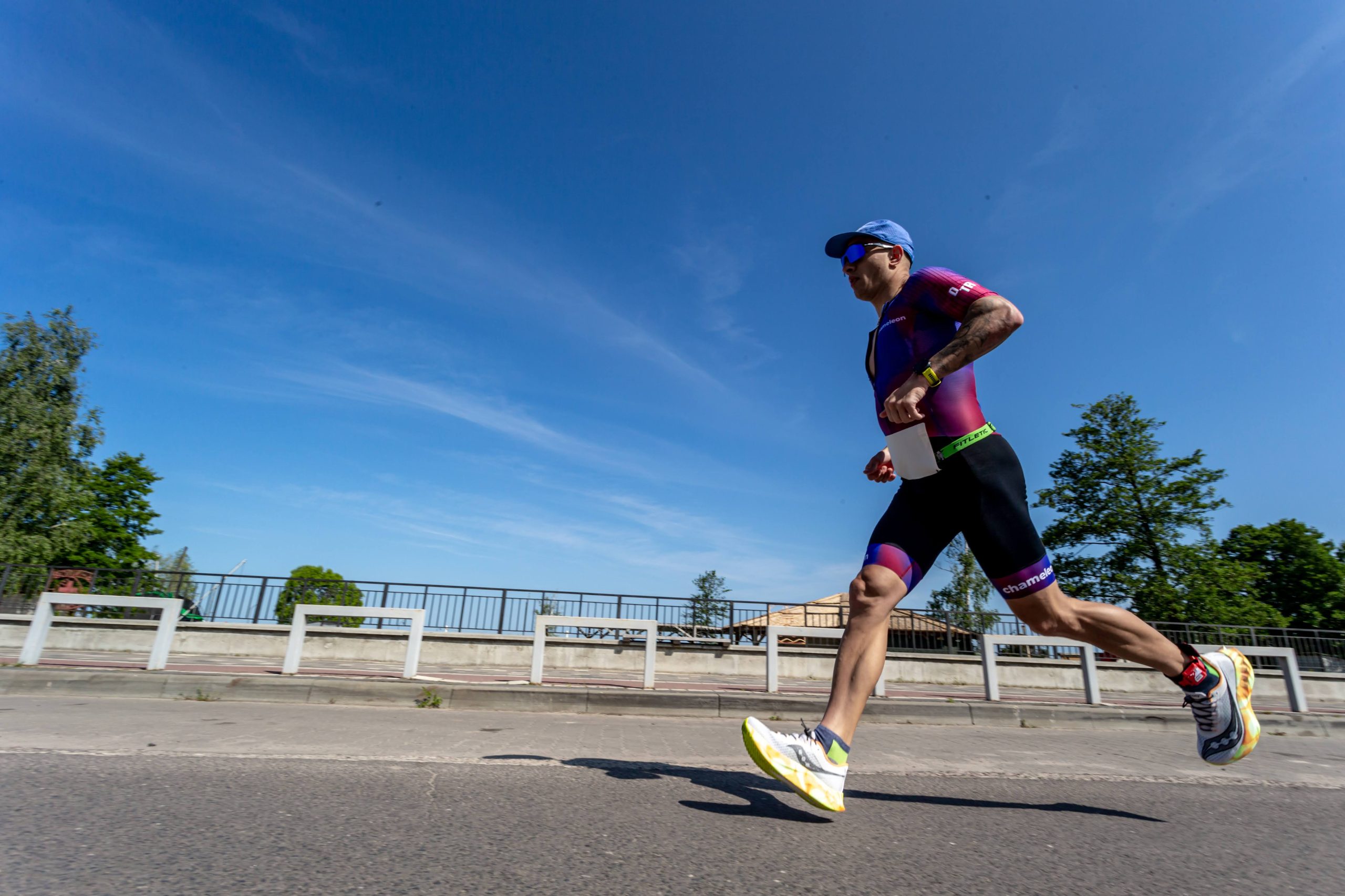Greetings, budding triathletes, and welcome to the gateway of triumph.
Where adrenaline meets endurance, and passion converges with performance.
As you gear up for the exhilarating world of triathlon racing, a paramount decision awaits: choosing the optimal bike for triathlon.
On the following pages, we’ll take you through the ins and outs of this important, carefully considered choice.
This will help those who are embarking on their first journey into the triathlon.
Step 1. Self-Assessment and Goal Setting: Crafting Your Triathlon Blueprint
Before you immerse yourself in the world of bike frames and gear ratios, pause for introspection.
Imagine your race day triumph and set your personal goals ablaze.
“The journey of a thousand miles begins with a single step,” said Lao Tzu, and so does your journey toward choosing the perfect triathlon bike.
1. Mapping Your Terrain
Position yourself on the triathlon spectrum.
Are you a rookie ready to embrace your first sprint, or a seasoned contender seeking the Ironman’s ultimate challenge?
This self-assessment shapes the contours of your choice.
At the same time, it ensures that it is perfectly aligned with your ambitions.
2. Fitness, Your Silent Ally
Consider the harmony between your body’s symphony and the tri bike’s melody.
Is cycling your forte, or do you crave equilibrium across swimming, cycling, and running?
Your fitness profile guides your choice of bike.
It combines power, endurance, and determination into a harmonious combination.
3. A Marriage of Intent and Race
Triathlons unfold like stories, each with its narrative.
Envision your tale—sprint, Olympic, or Ironman.
The ironman bike becomes your co-author, composing chapters in tune with the race’s rhythm.
Uphill battles, open roads, and varied terrains are all scenes to consider as your bike joins your narrative.
4. Guidance from Sages: Insights from Experts and Insiders:
In this pursuit, sage counsel guides the way.
Listen closely to voices seasoned by experience.
Triathlon guru, Coach Alex Rivers, imparts,
“Your tri bike is your partner in the symphony of triathlon.
It amplifies your strengths, bridges your gaps, and propels you toward your symphonic finish.”
With self-assessment and goal-setting as your compass, you’ve embarked on a journey of enlightenment.
Specifically, a journey guided by self-awareness and lit by a vision for your future in triathlon.
Now let’s dive into the anatomy of best bike for triathlon.
Its essential characteristics enhance your skill, improve your performance, and pave the way to victory.
Step 2. Frame Geometry and Material: Crafting Cycling Performance
Frame geometry and material are the fundamental elements that define your cycling experience.
Let’s delve into this important aspect of choosing the best triathlon bike.
It’s where precision meets engineering to enhance your performance.

1. Understanding Frame Geometry: The Blueprint of Performance
Frame geometry is akin to a blueprint, determining how your triathlon bike interacts with the road and the air.
It’s the science behind your posture, comfort, and aerodynamics—a symphony of angles, lengths, and alignments.
2. Distinctions in Frame Geometry: Road, Triathlon, and Time Trial Bikes
Different types of bikes for triathlon—road, triathlon, and time trial—manifest unique geometry.
Road Bikes
Designed for versatility, road bikes feature a more upright geometry for extended comfort during long rides.
They balance aerodynamics and comfort, making them suitable for various terrains.
Triathlon Bikes
Triathlon bikes are optimized for aerodynamics, triathlon bikes boast aero bars, steeper seat tube angles, and elongated tube profiles.
This geometry streamlines your body, reducing wind resistance for maximum speed during the cycling leg of a triathlon.
Time Trial Bikes
These specialized machines are built for the race against the clock.
Time trial bikes exhibit an aggressive geometry with elongated top tubes, steep seat angles, and a forward rider position.
Their design slices through the air, ideal for solo racing.
3. Materials and Their Impact: Exploring Frame Composition
The material of your Ironman bike’s frame contributes to its performance.
Carbon Fiber
Revered for its lightweight and stiffness, carbon fiber frames offer optimal power transfer and shock absorption.
Their versatility caters to a range of riding styles.
Aluminum
Known for its durability and affordability, aluminum frames provide a responsive feel on the road.
They excel in sprinting and climbing, making them a popular choice among riders.
Titanium
Titanium frames combine strength and resilience with a smooth ride quality.
Their corrosion resistance and unique aesthetics appeal to those seeking a blend of performance and artistry.

4. Frame Geometry’s Role in Performance
Frame geometry directly affects your cycling performance.
Recent research highlights how subtle geometry adjustments can lead to significant enhancements in efficiency and power transfer.
It’s the ergonomic backbone that ensures every pedal stroke propels you forward.
5. Personalized Performance: Tailoring Your Ride
Frame geometry isn’t just a technical aspect; it’s the art of fine-tuning your ride.
It’s about finding the harmony between comfort, speed, and control.
The geometry of your tri bike becomes an extension of your body, translating your energy into the road with precision and grace.
Now that we’ve explored the intricate dance between frame geometry and material, we’re moving on to the next important step in your journey.
There we will explain the importance of aerodynamics in cycling and how it improves speed.
In Step 3, we’ll dive into the world of explaining the benefits of reducing air resistance to improve energy conservation.
Join us as we dig into the nuances of this critical step and learn how these elements can make or break your cycling experience.
Step 3. Aerodynamics and Speed Improvement
In the pursuit of excellence, the realm of aerodynamics emerges as a vital factor in your quest for the ultimate bike for triathlon.
This step delves into the art and science of slicing through the air with finesse, a skill that can significantly enhance your speed and overall performance.
What is Aerodynamics?
Aerodynamics isn’t just a buzzword—it’s a game-changer.
By minimizing air resistance, you can unlock a world of enhanced energy efficiency and heightened speed.
To achieve this, consider incorporating elements such as aerodynamic grilles.
These are designed to reduce drag, and deep-section wheels that cut through the wind with elegant precision.
These aerodynamic enhancements work harmoniously with a streamlined frame design, further reducing resistance and propelling you forward.
In the realm of triathlon performance, aerodynamics stands as a formidable ally.
Picture yourself as an arrow, slicing through the air with minimal resistance.
This is where the magic of aerodynamic elements comes into play.
Examples of Aerodynamic Elements
Aero Bars
These futuristic extensions to your handlebars are more than just visually striking.
They’re engineered to minimize your frontal area and reduce drag.
By assuming a lower and more streamlined position, you’re not only cutting through the wind more efficiently but also optimizing your body’s interaction with the ironman bike.
Deep-Section Wheels
These wheels are more than meets the eye.
Their deep rims are designed to reduce turbulence around the spokes.
They improve overall aerodynamics.
As a result, you’ll experience less air resistance and more speed for the same effort.
Streamlined Frame Design
The frame of your bike isn’t just a skeletal structure—it’s a work of art designed to conquer the wind.
A streamlined frame design minimizes disruptions to the airflow, allowing you to glide through the atmosphere with reduced resistance.

What are the benefits of reduced air resistance?
The benefits of reducing air resistance extend beyond mere speed.
By optimizing your aerodynamics, you’re improving energy efficiency.
Think of it as getting more “bang for your buck” with every pedal stroke.
Less effort is required to maintain your desired pace, leaving you with valuable reserves of energy for the later stages of the race.
It’s a strategy that allows you to push your limits without depleting your reserves prematurely.
Examples of Professional Triathletes
When it comes to the real-world impact of aerodynamics, professional triathletes offer compelling case studies.
Consider the story of triathlete Cameron Wurf.
He is a former professional cyclist who became a triathlon champion.
Wurf’s meticulous attention to aerodynamics led him to impressive victories.
It is embodied in his sophisticated setup and strategic positioning
Research conducted by the Swiss Federal Institute of Technology Zurich also emphasizes the tangible benefits of reducing air resistance.
Their research shows that optimizing aerodynamics can lead to significant time savings over long distances.
In doing so, they demonstrate the critical role it plays in maximizing performance in triathlon.
As you navigate the intricacies of selecting the perfect triathlon bike, remember that mastering the art of aerodynamics isn’t just about speed.
It’s about transforming your ride into a harmonious dance with the wind, where every movement becomes a testament to your dedication to excellence.
While speed is essential, comfort is equally crucial.
Let’s delve into the realm of tri bike fit and how it can impact your overall performance.
Step 4. Prioritizing Comfort and Fit
In the quest for triathlon excellence, Comfort becomes an unsung hero.
A comfortable bike fit isn’t just a luxury; it’s an essential ingredient that can make or break your race day experience.
Comfort While Riding a Bike
Saddle Comfort
The saddle—the holy grail of a comfortable ride.
Think of it as your throne of endurance.
A well-fitting saddle ensures that your hours in the saddle are free from numbness, chafing, and discomfort.
It’s a place where your body and bike form a harmonious alliance.
Allowing you to focus on results without being distracted by discomfort.
Handlebar Position
Your handlebars aren’t just for steering; they’re your conduits of control and comfort.
An optimal handlebar position ensures that your wrists, shoulders, and neck are in ergonomic alignment.
It’s a symphony of biomechanics that translates into reduced stress, improved agility, and lasting comfort.
And also, the decisive factors for conquering both short sprints and long-distance races.
Bike Size
Picture this: a bike that’s perfectly proportioned to your body, a seamless extension of your movement.
Choosing the right bike size is akin to selecting the best tri suit.
It’s about enhancing your performance and minimizing unnecessary stress on your body.
A properly sized Ironman bike provides a foundation of comfort, enabling you to channel your energy into the race rather than battling discomfort.

What Happens If You Neglect Comfort?
The stakes of neglecting comfort are high.
An improper bike fit can lead to a cascade of issues, from nagging aches to outright pain.
It can compromise your form, erode your energy, and hinder your ability to unleash your full potential.
Experts in the world of triathlon emphasize that discomfort is more than a mere nuisance.
It’s a silent saboteur that can derail your race day ambitions.
Imagine contrasting scenarios: one where you’re wrapped in a cocoon of comfort, every pedal stroke a testament to your physical prowess.
And the other, where discomfort spoils every moment, undermining your confidence and focus.
Prioritizing comfort isn’t a luxury, it’s a strategic decision.
It increases your stability, extends your endurance, and enables you to finish in triumph.
When choosing your ideal triathlon bike, remember that it’s not just a piece of equipment.
It’s an extension of your aspirations.
The right fit, comfort, and adaptability will make your bike a reliable companion.
Now that your body and tri bike are in harmonious coexistence, let’s embark on an intriguing expedition through the terrain of different bike types.
Step 5. Choosing the Right Bike Type
Triathlon bikes come in many different types, each tailored to different racing styles and preferences.
It’s like choosing between a sleek sports car, a nimble roadster, and a rugged off-roader; each one is designed to conquer a specific terrain.
Whether you’re looking for open road speed or optimal aerodynamics, we’ll break down the unique benefits of each type of triathlon bike.
This will help you make an informed decision.
Triathlon bikes are not one-size-fits-all.
They come in a variety of types, each meticulously engineered to cater to specific racing styles, terrains, and individual preferences.
Consider this stage as your moment to curate your ultimate race-day partner— the right bike that aligns with your goals and racing vision.
1. Triathlon Bike
The quintessential choice for triathletes seeking to optimize aerodynamics and speed.
Designed with aerodynamic efficiency in mind, these bikes feature aerobars, aero frames, and specialized geometry to minimize wind resistance and propel you toward your personal best.
Perfect for flat and rolling courses, they transform your pedaling power into a symphony of speed.

2. Road Bike
The versatile workhorse of cycling, the road triathlon bike combines speed, agility, and endurance.
Its lightweight frame and versatile design make it a go-to choice for triathletes who embrace a mix of road cycling and triathlon training.
While it may not offer the same aerodynamic prowess as a triathlon bike, it compensates with agility, comfort, and the ability to tackle varied terrain.

3. Time Trial Bike
Picture yourself in a solo race against the clock, focused on shaving off precious seconds.
Enter the time trial bike—a specialized breed designed for maximum speed on flat and time-bound courses.
With a focus on aerodynamics and efficiency, these bikes often feature elongated aero bars and a distinctive frame geometry that slices through the air.
If your heart beats for individual time trials, this bike is your steadfast ally.
Each type of tri bike presents a unique blend of advantages, shaped by its purpose and design.
The bike for a triathlon is your arrow of speed; the road bike, your jack of all trades; and the time trial bike, your instrument of precision.
As you delve into the realm of bike selection, envision your racing style, terrain preferences, and long-term aspirations.
Imagine the euphoria of gliding effortlessly on a triathlon bike.
Or the adrenaline rush of cornering a road tri bike, or the laser-like focus of a time trial bike as you race against the clock.
Your choice extends beyond triathlon equipment—it’s a partnership that will accompany you on your journey to triumph.
With a deeper understanding of the distinct roles these bike types play, you’re primed to align your choice with your unique racing identity.
From the fast winds of the triathlon to the scenic twists and turns of the road.
The type of tri bike you choose will be the vehicle through which you can channel your determination, passion, and drive for excellence.

Conclusion
As you stand at the crossroads of selecting the perfect triathlon bike, armed with newfound insights, you’re poised to embark on a journey of precision and personalization.
The steps we’ve explored—self-assessment, frame geometry, aerodynamics, comfort, and bike type.
These are the guiding stars that will lead you toward a bike that seamlessly aligns with your racing aspirations.
Remember, the road to triathlon success is not paved with hasty decisions but rather with meticulous research and tailored choices.
Your tri bike is not just a tool; it’s an extension of your determination, a conduit for your ambitions, and a partner in your pursuit of excellence.
When choosing from the many options, focus on what fits your unique combination of goals and strengths.
Be sure you’re on your way to purchasing not just a bike, but the embodiment of your racing personality.
Now, with these insights in hand, venture forth into the world of triathlon bike selection with confidence.
Embrace the thrill of curating your ultimate race-day companion and channel your dedication into a decision that mirrors your commitment to triathlon success.
The podium awaits, and with the best bike for triathlon propelling you forward, you’re primed to conquer your goals and etch your name among the champions.







